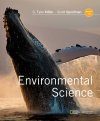About this book
The 16th Edition of Environmental Science aims to inspire people to care about the planet. Partnering with National Geographic Learning, the authors Tyler Miller and Scott Spoolman deliver a text that equips and inspires readers with the tools and knowledge to make a difference solving today's environmental issues. Exclusive content highlights important work of National Geographic explorers and grantees and features vivid photos, maps and illustrations that bring course concepts to life. Using sustainability as their central theme, the authors emphasize natural capital, natural capital degradation, solutions, trade-offs and the importance of individuals. In return, students learn how nature works, how you interact with it and how humanity can continue to sustain its relationship with the earth by applying nature's lessons to economies and individual lifestyles.
New features in the 16th edition:
- The new "Learning from Nature" feature appears in most chapters and includes a set of brief summaries of specific applications of biomimicry in various industries and fields of research.
- New visual elements inspired by National Geographic Learning that capture and hold students' attention.
- New Core Case Studies for eight of the book's 17 chapters enable students to apply text concepts and principles to current, real-world issues.
- Providing a heavier emphasis on data analysis, the 16th edition adds new questions to the captions of all figures that involve data graphs, prompting students to analyze the data represented in the figure. This hands-on activity complements the end-of-chapter exercises.
- Updated throughout using thousands of articles and reports published between 2013 and 2017, major new or updated topics range from fracking to the Northern Pacific Garbage Patch with a wealth of hot and emerging issues in between.
- An all-new Econumbers feature highlights key statistics that are helpful for students to remember.
- The 16th edition now includes a more thorough treatment of the history of environmental conservation and protection in the United States, helping students see the big picture.
Contents
Part 1. HUMANS AND SUSTAINABILITY: AN OVERVIEW
1. The Environment and Sustainability
Part II. ECOLOGY AND SUSTAINABILITY
2. Science, Matter, Energy and Systems
3. Ecosystems: What Are They and How Do They Work
4. Biodiversity and Evolution
5. Species Interactions, Ecological Succession and Population Control
6. The Human Population and Urbanization
7. Climate and Biodiversity
Part III. SUSTAINING BIODIVERSITY
8. Sustaining Biodiversity: Saving Species
9. Sustaining Biodiversity: Saving Ecosystems
Part IV. SUSTAINING RESOURCES AND ENVIRONMENTAL QUALITY
10. Food Production and the Environment
11. Water Resources and Water Pollution
12. Geology and Nonrenewable Mineral Resources
13. Energy Resources
14. Environmental Hazards and Human Health
15. Air Pollution, Climate Change and Ozone Depletion
16. Solid and Hazardous Waste
Part V. SUSTAINING HUMAN SOCIETIES
17. Environmental Economics, Politics and Worldviews
Glossary
Index
Preface
About the Authors
From the Authors
Learning Skills
Customer Reviews
Biography
Scott Spoolman is a writer and textbook editor with more than 30 years of experience in educational publishing. He has worked with Tyler Miller since 2003 as a contributing author on editions of Living in the Environment, Environmental Science, and Sustaining the Earth. With Norman Myers, he also coauthored Environmental Issues and Solutions: A Modular Approach. Spoolman holds a master's degree in science journalism from the University of Minnesota. He has authored numerous articles in the fields of science, environmental engineering, politics, and business. He worked as an acquisitions editor on a series of college forestry textbooks. He has also worked as a consulting editor in the development of over 70 college and high school textbooks in fields of the natural and social sciences. In his free time, he enjoys exploring the forests and waters of his native Wisconsin along with his family- his wife, environmental educator Gail Martinelli, and his children, Will and Katie.
G. Tyler Miller has written 62 textbooks for introductory courses in environmental science, basic ecology, energy, and environmental chemistry. Since 1975, Miller's books have been the most widely used textbooks for environmental science in the United States and throughout the world. They have been used by almost three million students and have been translated into eight languages. Miller has a professional background in chemistry, physics, and ecology. He has a PhD from the University of Virginia and has received two honorary doctoral degrees for his contributions to environmental education. He taught college for 20 years, developed one of the nation's first environmental studies programs, and developed an innovative interdisciplinary undergraduate science program before deciding to write environmental science textbooks full time in 1975. Currently, he is the president of Earth Education and Research, which is devoted to improving environmental education.
































